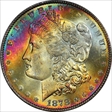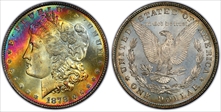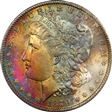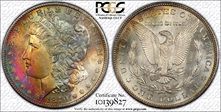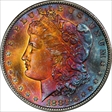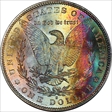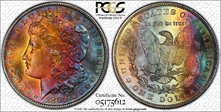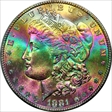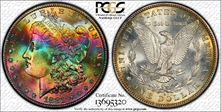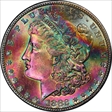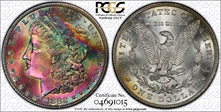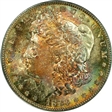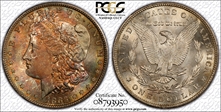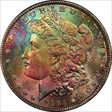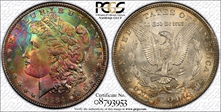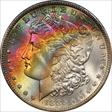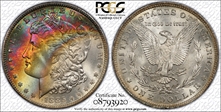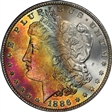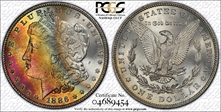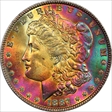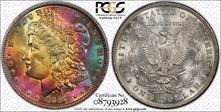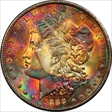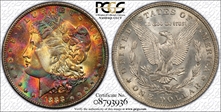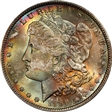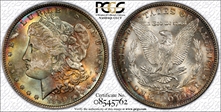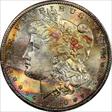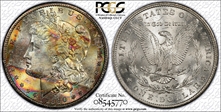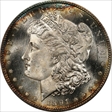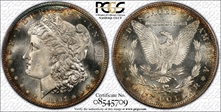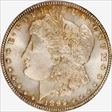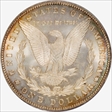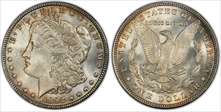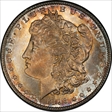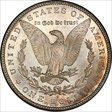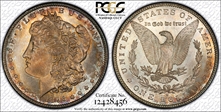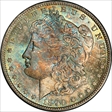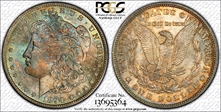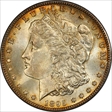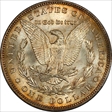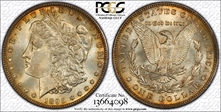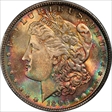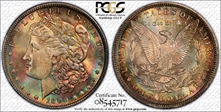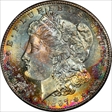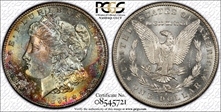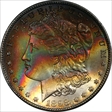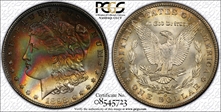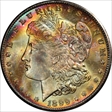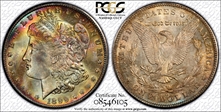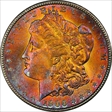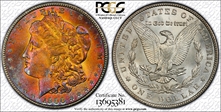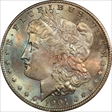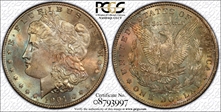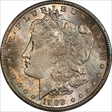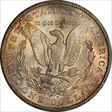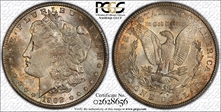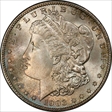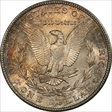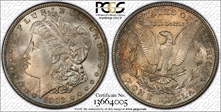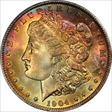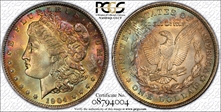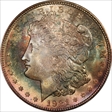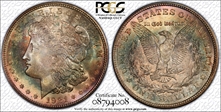Sunnywood's "Somewhere Over the Rainbow" Date Set #1 的钱币相册
The popular "8TF" (eight tail feathers) variety marks the first adopted reverse for the new silver dollars of 1878. The design was later revised to seven tail feathers in accordance with Morgan's original intent, although the even number eight is actually more accurate. (According to Hawk Mountain's Research Center, most large birds of prey including the Bald Eagle have precisely 12 tail feathers, an even number.) This spectacular coin has some prooflike characteristics, exciting eye appeal, and PQ technical qualities - high end for the assigned grade. Ex Bowers & Merena, Baltimore (11/10/06:3521); previously ex Dale Larsen; Larry Shapiro; Superior, pre-Long Beach Sale (6/1/04:3105)
The popular "8TF" (eight tail feathers) variety marks the first adopted reverse for the new silver dollars of 1878. The design was later revised to seven tail feathers in accordance with Morgan's original intent, although the even number eight is actually more accurate. (According to Hawk Mountain's Research Center, most large birds of prey including the Bald Eagle have precisely 12 tail feathers, an even number.) This spectacular coin has some prooflike characteristics, exciting eye appeal, and PQ technical qualities - high end for the assigned grade. Ex Bowers & Merena, Baltimore (11/10/06:3521); previously ex Dale Larsen; Larry Shapiro; Superior, pre-Long Beach Sale (6/1/04:3105)
One of the highlights of Sunnywood's "Somewhere Over the Rainbow" toned Morgan dollar collection; an extraordinary and record-setting example of an otherwise common date; this technically superb monster features an intensely toned obverse with blues, pinks and true gold, miraculously paired with lustrous classic vertically banded rainbow toning on the reverse. The left-to-right toning progression on both sides corresponds perfectly directionally, indicating that the two-sided toning likely formed simultaneously during decades of Mint bag storage. The obverse occupies a narrower band of the color progression than the reverse, showing that the air flow characteristic across the surface was different for the two sides. Perhaps the reverse lay facing up in the Mint bag, but the coin was propped up at the rim, thus allowing limited air flow across the obverse as well. The coin had the exact same appearance when it was sold at auction in 1983, proving that the toning is highly stable and formed naturally over a long period. Ex RARCOA, Auction '83 (7/83:1182); held in one collection for 23 years; ANR, New York Connoisseur's Collection Sale (3/14/06:1147).
One of the highlights of Sunnywood's "Somewhere Over the Rainbow" toned Morgan dollar collection; an extraordinary and record-setting example of an otherwise common date; this technically superb monster features an intensely toned obverse with blues, pinks and true gold, miraculously paired with lustrous classic vertically banded rainbow toning on the reverse. The left-to-right toning progression on both sides corresponds perfectly directionally, indicating that the two-sided toning likely formed simultaneously during decades of Mint bag storage. The obverse occupies a narrower band of the color progression than the reverse, showing that the air flow characteristic across the surface was different for the two sides. Perhaps the reverse lay facing up in the Mint bag, but the coin was propped up at the rim, thus allowing limited air flow across the obverse as well. The coin had the exact same appearance when it was sold at auction in 1983, proving that the toning is highly stable and formed naturally over a long period. Ex RARCOA, Auction '83 (7/83:1182); held in one collection for 23 years; ANR, New York Connoisseur's Collection Sale (3/14/06:1147).
One of the highlights of Sunnywood's "Somewhere Over the Rainbow" toned Morgan dollar collection; an extraordinary and record-setting example of an otherwise common date; this technically superb monster features an intensely toned obverse with blues, pinks and true gold, miraculously paired with lustrous classic vertically banded rainbow toning on the reverse. The left-to-right toning progression on both sides corresponds perfectly directionally, indicating that the two-sided toning likely formed simultaneously during decades of Mint bag storage. The obverse occupies a narrower band of the color progression than the reverse, showing that the air flow characteristic across the surface was different for the two sides. Perhaps the reverse lay facing up in the Mint bag, but the coin was propped up at the rim, thus allowing limited air flow across the obverse as well. The coin had the exact same appearance when it was sold at auction in 1983, proving that the toning is highly stable and formed naturally over a long period. Ex RARCOA, Auction '83 (7/83:1182); held in one collection for 23 years; ANR, New York Connoisseur's Collection Sale (3/14/06:1147).
Considered by some enthusiasts to be the ultimate finest toned Morgan known to the collecting community, this paradigm of perfection features rich vibrant banded rainbow toning over essentially flawless and highly lustrous surfaces. This coin was the favorite centerpiece of longtime collector extraordinaire Ron Sirna, whose love of beautifully toned coins led him to found the Toned Coin Collectors Society. The "Sirna Moose" starred solo in full-page color ad campaign by ANACS (whien the coin was in an ANACS MS68 holder), and is also the centerpiece of a beautiful poster created by Ron for the Toned Coin Collectors Society. Although the 1881-S is arguably the most common date in the series both generally and with color, this specimen sits at the pinnacle of the many surviving examples, and is a highlight of The Sunnywood Collection.
Considered by some enthusiasts to be the ultimate finest toned Morgan known to the collecting community, this paradigm of perfection features rich vibrant banded rainbow toning over essentially flawless and highly lustrous surfaces. This coin was the favorite centerpiece of longtime collector extraordinaire Ron Sirna, whose love of beautifully toned coins led him to found the Toned Coin Collectors Society. The "Sirna Moose" starred solo in full-page color ad campaign by ANACS (whien the coin was in an ANACS MS68 holder), and is also the centerpiece of a beautiful poster created by Ron for the Toned Coin Collectors Society. Although the 1881-S is arguably the most common date in the series both generally and with color, this specimen sits at the pinnacle of the many surviving examples, and is a highlight of The Sunnywood Collection.
Featured on the front of the color brochure prepared by PCGS for the display of the Sunnywood Collection, this coin was chosen most often as the favorite in the set by collectors who visited the display. It was once dubbed "The Electric Rainbow Wonder Coin" by Morgan dollar specialist Michael Casper. Like the 1879-S, 1880-S and 1881-S dollars in the set, this spectacular coin is an exceptionally beautiful and technically superb example of what would otherwise be a common date San Francisco Morgan dollar. From the collection of our friend Gregg Bingham, who also happens to be a well-known former Houston Oilers middle linebacker, and a world-class coin collector. Gregg's "NFL Set" was one of the best collections of Morgans ever to be sold at auction (Heritage, FUN 2001), but this special "monster" was kept back by him and later sold privately to Sunnywood. The 1888-O in this set is also one of Gregg's "private monsters," while the magnificent 1892-CC was in his NFL Set.
Featured on the front of the color brochure prepared by PCGS for the display of the Sunnywood Collection, this coin was chosen most often as the favorite in the set by collectors who visited the display. It was once dubbed "The Electric Rainbow Wonder Coin" by Morgan dollar specialist Michael Casper. Like the 1879-S, 1880-S and 1881-S dollars in the set, this spectacular coin is an exceptionally beautiful and technically superb example of what would otherwise be a common date San Francisco Morgan dollar. From the collection of our friend Gregg Bingham, who also happens to be a well-known former Houston Oilers middle linebacker, and a world-class coin collector. Gregg's "NFL Set" was one of the best collections of Morgans ever to be sold at auction (Heritage, FUN 2001), but this special "monster" was kept back by him and later sold privately to Sunnywood. The 1888-O in this set is also one of Gregg's "private monsters," while the magnificent 1892-CC was in his NFL Set.
This superb gem CC dollar features strong coral and peach toning covering much of Miss Liberty's portrait, with a lovely mélange of teal blues and greens mixed with sunset yellow, gold and orange hues in the surrounding areas. A treat from Anaconda Rare Coins.
This superb gem CC dollar features strong coral and peach toning covering much of Miss Liberty's portrait, with a lovely mélange of teal blues and greens mixed with sunset yellow, gold and orange hues in the surrounding areas. A treat from Anaconda Rare Coins.
Collectors of toned morgans know that 1884 is a date that is very seldom found with nice color, and virtually never with "monster" color. This coin is the exception! Here is an outrageous 100% obverse rainbow bag-toned example, with heavy thick colors of reds, golds, greens and blues. These colors would be unusual and attractive for any date, but are downright incredible for an 1884-P. From long-time toned Morgan dealer Mike De Falco.
Collectors of toned morgans know that 1884 is a date that is very seldom found with nice color, and virtually never with "monster" color. This coin is the exception! Here is an outrageous 100% obverse rainbow bag-toned example, with heavy thick colors of reds, golds, greens and blues. These colors would be unusual and attractive for any date, but are downright incredible for an 1884-P. From long-time toned Morgan dealer Mike De Falco.
For the more common dates in the series, Sunnywood has had many coins to choose from. The result is that our examples of the common dates are generally quite spectacular. Here is another superb gem classic banded rainbow-toned dollar; compare this coin with the very similarly toned 1879-S in this set. It is fun to pick out pairs of coins with similar matched toning. From Mike DeFalco (Numismatic Enterprises).
For the more common dates in the series, Sunnywood has had many coins to choose from. The result is that our examples of the common dates are generally quite spectacular. Here is another superb gem classic banded rainbow-toned dollar; compare this coin with the very similarly toned 1879-S in this set. It is fun to pick out pairs of coins with similar matched toning. From Mike DeFalco (Numismatic Enterprises).
This superb gem has a 65% obverse crescent rainbow with an unusual amount of orange where the broad yellow and red bands overlap. From Dick Abrahams (Great Toning LLC).
This superb gem has a 65% obverse crescent rainbow with an unusual amount of orange where the broad yellow and red bands overlap. From Dick Abrahams (Great Toning LLC).
A gorgeous blast of vibrant reds, yellows and greens; one of the finest toned Morgan dollars from the incredible "Battle Creek" Collection, which was auctioned by Superior in four events during the 2005-2006 season. The Battle Creek coins included many fabulously colorful examples, mainly dated 1886 and 1887, with somewhat fewer 1885 and a small number of toned 1904-O dollars. ex Battle Creek Collection, Superior Galleries(7/23/05:1348) as NGC MS66*; Mike DeFalco (Numismatic Enterprises).
A gorgeous blast of vibrant reds, yellows and greens; one of the finest toned Morgan dollars from the incredible "Battle Creek" Collection, which was auctioned by Superior in four events during the 2005-2006 season. The Battle Creek coins included many fabulously colorful examples, mainly dated 1886 and 1887, with somewhat fewer 1885 and a small number of toned 1904-O dollars. ex Battle Creek Collection, Superior Galleries(7/23/05:1348) as NGC MS66*; Mike DeFalco (Numismatic Enterprises).
A wildly toned monster end-roller with intense red, orange, green, yellow and other hues of multi-colored toning in a crazy pattern over pristine smooth surfaces. Certainly one of the most compelling examples of this date in existence. Ex Mid-America Rare Coin Auctions, 1988 Peach State Sale (9/2/88); the poster for that sale, featuring this coin, was given a full-page color plate in John Highfill's Comprehensive U.S. Silver Dollar Encyclopedia (published April 1992; see p. 839). The coin resurfaced at the February 2002 Long Beach show, where it was purchased by Mike DeFalco and placed with Gregg Bingham; later bought back by DeFalco and placed with Sunnywood in Feb. 2004. We expect this coin to stay put in the Sunnywood Collection for quite some time to come.
A wildly toned monster end-roller with intense red, orange, green, yellow and other hues of multi-colored toning in a crazy pattern over pristine smooth surfaces. Certainly one of the most compelling examples of this date in existence. Ex Mid-America Rare Coin Auctions, 1988 Peach State Sale (9/2/88); the poster for that sale, featuring this coin, was given a full-page color plate in John Highfill's Comprehensive U.S. Silver Dollar Encyclopedia (published April 1992; see p. 839). The coin resurfaced at the February 2002 Long Beach show, where it was purchased by Mike DeFalco and placed with Gregg Bingham; later bought back by DeFalco and placed with Sunnywood in Feb. 2004. We expect this coin to stay put in the Sunnywood Collection for quite some time to come.
While colorfully toned examples of the 1889-P issue can be located, they are almost non-existent at the coveted MS66 level. We have owned some nice examples in the MS64-MS65 range, but this MS66 has had no peers among those we have studied. The fascinatingly toned MS65 in our duplicates set has such an interesting enough toning pattern that we had it in the main set for a while, but we have now restored the MS66 to its rightful place. From Mike DeFalco; previously out of a Heritage sale.
While colorfully toned examples of the 1889-P issue can be located, they are almost non-existent at the coveted MS66 level. We have owned some nice examples in the MS64-MS65 range, but this MS66 has had no peers among those we have studied. The fascinatingly toned MS65 in our duplicates set has such an interesting enough toning pattern that we had it in the main set for a while, but we have now restored the MS66 to its rightful place. From Mike DeFalco; previously out of a Heritage sale.
This wonderful end-roll toner hails from the same auction consignment as the stunning 1889-S and 1897-S examples in this set. It would be fascinating to know how these better-date San Francisco coins came to have such colorful toning; two of the three are clearly end-rollers, and are not the usual Redfield examples of these dates. ANR, LaBelle Sale (7/25/05:1545).
This wonderful end-roll toner hails from the same auction consignment as the stunning 1889-S and 1897-S examples in this set. It would be fascinating to know how these better-date San Francisco coins came to have such colorful toning; two of the three are clearly end-rollers, and are not the usual Redfield examples of these dates. ANR, LaBelle Sale (7/25/05:1545).
A flashy semi-prooflike coin with frosty devices, and peripheral toning that is highlighted by a patch of electric blue atop the obverse. This coin perhaps the least toned coin in our collection, with very bright untoned centers. As such, it is always a candidate for replacement. The work of building the perfect set is never done!! Heritage, FUN Signature Sale (1/15/05:11566).
A flashy semi-prooflike coin with frosty devices, and peripheral toning that is highlighted by a patch of electric blue atop the obverse. This coin perhaps the least toned coin in our collection, with very bright untoned centers. As such, it is always a candidate for replacement. The work of building the perfect set is never done!! Heritage, FUN Signature Sale (1/15/05:11566).
The finest known 1892-O dollar; the Eliasberg specimen; the only '92-O graded MS67 by either service. The Sunnywood Collection is about balancing colorful toning with technical quality. While the MS64 in our duplicates set has marvelous colorful toning on both sides, and an excellent strike, we simply could not refuse the opportunity to include this original, subtly toned, single finest known specimen of the date. Creamy ivory "Eliasberg toning" is accented with russet and hints of sea-green and pale blue at the perimeters. This is one of "the group of six" (the branch Mint dollars of 1892 and 1893) that the elder Clapp acquired from well-heeled Philadelphia dealer J. Colvin Randall in early 1894. As such, we are happy to reunite this coin with the Clapp-Eliasberg 1893-S, also in our collection. As with all the coins in the group of six, the most plausible explanation for the extraordinary quality is that this may have been an early strike specimen carefully set aside for the Assay Commission. Ex J. Colvin Randall to J.M. Clapp in 1894; upon his passing, to his son J.H. Clapp in 1906; to Louis E. Eliasberg, Sr. as part of the Clapp estate purchase in 1942; to his son Richard A. Eliasberg upon the former's passing in 1976; Bowers & Merena, The Eliasberg Collection (4/8/97:2289); Mike Gilley; the Arno Collection; Heritage, FUN Sale (1/9/09:5011); acquired privately by Sunnywood (4/28/09).
The finest known 1892-O dollar; the Eliasberg specimen; the only '92-O graded MS67 by either service. The Sunnywood Collection is about balancing colorful toning with technical quality. While the MS64 in our duplicates set has marvelous colorful toning on both sides, and an excellent strike, we simply could not refuse the opportunity to include this original, subtly toned, single finest known specimen of the date. Creamy ivory "Eliasberg toning" is accented with russet and hints of sea-green and pale blue at the perimeters. This is one of "the group of six" (the branch Mint dollars of 1892 and 1893) that the elder Clapp acquired from well-heeled Philadelphia dealer J. Colvin Randall in early 1894. As such, we are happy to reunite this coin with the Clapp-Eliasberg 1893-S, also in our collection. As with all the coins in the group of six, the most plausible explanation for the extraordinary quality is that this may have been an early strike specimen carefully set aside for the Assay Commission. Ex J. Colvin Randall to J.M. Clapp in 1894; upon his passing, to his son J.H. Clapp in 1906; to Louis E. Eliasberg, Sr. as part of the Clapp estate purchase in 1942; to his son Richard A. Eliasberg upon the former's passing in 1976; Bowers & Merena, The Eliasberg Collection (4/8/97:2289); Mike Gilley; the Arno Collection; Heritage, FUN Sale (1/9/09:5011); acquired privately by Sunnywood (4/28/09).
The finest known 1892-O dollar; the Eliasberg specimen; the only '92-O graded MS67 by either service. The Sunnywood Collection is about balancing colorful toning with technical quality. While the MS64 in our duplicates set has marvelous colorful toning on both sides, and an excellent strike, we simply could not refuse the opportunity to include this original, subtly toned, single finest known specimen of the date. Creamy ivory "Eliasberg toning" is accented with russet and hints of sea-green and pale blue at the perimeters. This is one of "the group of six" (the branch Mint dollars of 1892 and 1893) that the elder Clapp acquired from well-heeled Philadelphia dealer J. Colvin Randall in early 1894. As such, we are happy to reunite this coin with the Clapp-Eliasberg 1893-S, also in our collection. As with all the coins in the group of six, the most plausible explanation for the extraordinary quality is that this may have been an early strike specimen carefully set aside for the Assay Commission. Ex J. Colvin Randall to J.M. Clapp in 1894; upon his passing, to his son J.H. Clapp in 1906; to Louis E. Eliasberg, Sr. as part of the Clapp estate purchase in 1942; to his son Richard A. Eliasberg upon the former's passing in 1976; Bowers & Merena, The Eliasberg Collection (4/8/97:2289); Mike Gilley; the Arno Collection; Heritage, FUN Sale (1/9/09:5011); acquired privately by Sunnywood (4/28/09).
This is the beautiful Eliasberg specimen, plated in "The 100 Greatest U.S. Coins." Believed to be one of a small handful of coins set aside for the Assay Commission, the Eliasberg 1893-S exhibits remarkably clean obverse fields and a flawless reverse, with only a few minor ticks on the portrait that prevent a full superb gem designation. The coin is highlighted by attractive light orginal toning over highly lustrous fields and a good strike. The provenance of this coin is uninterrupted since it left the Mint: ex Philadelphia dealer J. Colvin Randall, as part of a six-coin group comprising all of the branch mint Morgans of 1892 and 1893, which Randall likely obtained from the Assay Commission; to J.M. Clapp in 1894; upon his passing, to his son J.H. Clapp in 1906; to Louis E. Eliasberg, Sr. as part of the Clapp estate purchase in 1942; to his son Richard A. Eliasberg upon the former's passing in 1976; Bowers & Merena, The Eliasberg Collection (4/8/97:2294); purchased by the Stellar Collection at the Eliasberg Sale; to the Sunnywood Collection privately in January 2008. This example is universally considered to be among the top three survivors of this famous key issue. While the Vermeule (PCGS MS67) and Norweb (NGC MS67) specimens carry higher slab grades, the Eliasberg coin is considered by many to be the most attractive example, also well ahead of the Amon Carter PCGS MS65 and all other MS65's. Sadly, the Norweb coin, once considered the finest known, was dipped after the Norweb sale, and was recently "conserved" yet again.
This is the beautiful Eliasberg specimen, plated in "The 100 Greatest U.S. Coins." Believed to be one of a small handful of coins set aside for the Assay Commission, the Eliasberg 1893-S exhibits remarkably clean obverse fields and a flawless reverse, with only a few minor ticks on the portrait that prevent a full superb gem designation. The coin is highlighted by attractive light orginal toning over highly lustrous fields and a good strike. The provenance of this coin is uninterrupted since it left the Mint: ex Philadelphia dealer J. Colvin Randall, as part of a six-coin group comprising all of the branch mint Morgans of 1892 and 1893, which Randall likely obtained from the Assay Commission; to J.M. Clapp in 1894; upon his passing, to his son J.H. Clapp in 1906; to Louis E. Eliasberg, Sr. as part of the Clapp estate purchase in 1942; to his son Richard A. Eliasberg upon the former's passing in 1976; Bowers & Merena, The Eliasberg Collection (4/8/97:2294); purchased by the Stellar Collection at the Eliasberg Sale; to the Sunnywood Collection privately in January 2008. This example is universally considered to be among the top three survivors of this famous key issue. While the Vermeule (PCGS MS67) and Norweb (NGC MS67) specimens carry higher slab grades, the Eliasberg coin is considered by many to be the most attractive example, also well ahead of the Amon Carter PCGS MS65 and all other MS65's. Sadly, the Norweb coin, once considered the finest known, was dipped after the Norweb sale, and was recently "conserved" yet again.
This is the beautiful Eliasberg specimen, plated in "The 100 Greatest U.S. Coins." Believed to be one of a small handful of coins set aside for the Assay Commission, the Eliasberg 1893-S exhibits remarkably clean obverse fields and a flawless reverse, with only a few minor ticks on the portrait that prevent a full superb gem designation. The coin is highlighted by attractive light orginal toning over highly lustrous fields and a good strike. The provenance of this coin is uninterrupted since it left the Mint: ex Philadelphia dealer J. Colvin Randall, as part of a six-coin group comprising all of the branch mint Morgans of 1892 and 1893, which Randall likely obtained from the Assay Commission; to J.M. Clapp in 1894; upon his passing, to his son J.H. Clapp in 1906; to Louis E. Eliasberg, Sr. as part of the Clapp estate purchase in 1942; to his son Richard A. Eliasberg upon the former's passing in 1976; Bowers & Merena, The Eliasberg Collection (4/8/97:2294); purchased by the Stellar Collection at the Eliasberg Sale; to the Sunnywood Collection privately in January 2008. This example is universally considered to be among the top three survivors of this famous key issue. While the Vermeule (PCGS MS67) and Norweb (NGC MS67) specimens carry higher slab grades, the Eliasberg coin is considered by many to be the most attractive example, also well ahead of the Amon Carter PCGS MS65 and all other MS65's. Sadly, the Norweb coin, once considered the finest known, was dipped after the Norweb sale, and was recently "conserved" yet again.
One of our favorites in the set, this gem original 1894 dollar displays a full palette of blues, including electric turquoise, azure and teal tones amidst an original skin of light pewter and rose-toned silver surfaces. The 1894 is a semi-key date that has always been highly respected by Morgan dollar specialists. Among P-mint business strikes, it is challenged only by the 1901. (The 1895-P business strike is a mythical beast, not believed to exist.)
One of our favorites in the set, this gem original 1894 dollar displays a full palette of blues, including electric turquoise, azure and teal tones amidst an original skin of light pewter and rose-toned silver surfaces. The 1894 is a semi-key date that has always been highly respected by Morgan dollar specialists. Among P-mint business strikes, it is challenged only by the 1901. (The 1895-P business strike is a mythical beast, not believed to exist.)
We are thrilled to include this gem 1895-O dollar from the Norweb Collection in the Sunnywood set. The '95-O is a key date in the Morgan dollar series, and is notoriously difficult in higher mint state grades. It is the only date in the series that was not represented in any of the Treasury releases. No bags of 1895-O dollars were ever found in bank vault storage. Fewer than a dozen gems exist, and the real number may be smaller still. Of these, we know of only three that are still in undipped original condition, saved at or near the time of original issue: the present Norweb coin, the Eliasberg coin, and a deeply toned example from an original match-toned 1895-O Mint set owned by David Akers and later placed in Charles Lamborn's fabulous "Fairfield Collection". Happily, the Norweb coin features attractive toning, a good strike for the date, ample luster and great eye appeal. Purchased by Albert Fairchild Holden from J.W. Scott & Co., October 26, 1908, as part of a group of "O" mint dollars including the 1893-O, and 1895-O through 1898-O (J.W. Scott had apparently ordered each of these directly from the New Orleans Mint in the year of issue); to his daughter Emery May Holden Norweb; to her son R. Henry Norweb, Jr.; auctioned by Bowers & Merena, The Norweb Collection Part III (11/15/88:3892). Later part of the Michael Casper Collection; thence to the Arno Collection; Heritage, 2009 FUN (1/9/09:5037); to the Sunnywood Collection.
We are thrilled to include this gem 1895-O dollar from the Norweb Collection in the Sunnywood set. The '95-O is a key date in the Morgan dollar series, and is notoriously difficult in higher mint state grades. It is the only date in the series that was not represented in any of the Treasury releases. No bags of 1895-O dollars were ever found in bank vault storage. Fewer than a dozen gems exist, and the real number may be smaller still. Of these, we know of only three that are still in undipped original condition, saved at or near the time of original issue: the present Norweb coin, the Eliasberg coin, and a deeply toned example from an original match-toned 1895-O Mint set owned by David Akers and later placed in Charles Lamborn's fabulous "Fairfield Collection". Happily, the Norweb coin features attractive toning, a good strike for the date, ample luster and great eye appeal. Purchased by Albert Fairchild Holden from J.W. Scott & Co., October 26, 1908, as part of a group of "O" mint dollars including the 1893-O, and 1895-O through 1898-O (J.W. Scott had apparently ordered each of these directly from the New Orleans Mint in the year of issue); to his daughter Emery May Holden Norweb; to her son R. Henry Norweb, Jr.; auctioned by Bowers & Merena, The Norweb Collection Part III (11/15/88:3892). Later part of the Michael Casper Collection; thence to the Arno Collection; Heritage, 2009 FUN (1/9/09:5037); to the Sunnywood Collection.
We are thrilled to include this gem 1895-O dollar from the Norweb Collection in the Sunnywood set. The '95-O is a key date in the Morgan dollar series, and is notoriously difficult in higher mint state grades. It is the only date in the series that was not represented in any of the Treasury releases. No bags of 1895-O dollars were ever found in bank vault storage. Fewer than a dozen gems exist, and the real number may be smaller still. Of these, we know of only three that are still in undipped original condition, saved at or near the time of original issue: the present Norweb coin, the Eliasberg coin, and a deeply toned example from an original match-toned 1895-O Mint set owned by David Akers and later placed in Charles Lamborn's fabulous "Fairfield Collection". Happily, the Norweb coin features attractive toning, a good strike for the date, ample luster and great eye appeal. Purchased by Albert Fairchild Holden from J.W. Scott & Co., October 26, 1908, as part of a group of "O" mint dollars including the 1893-O, and 1895-O through 1898-O (J.W. Scott had apparently ordered each of these directly from the New Orleans Mint in the year of issue); to his daughter Emery May Holden Norweb; to her son R. Henry Norweb, Jr.; auctioned by Bowers & Merena, The Norweb Collection Part III (11/15/88:3892). Later part of the Michael Casper Collection; thence to the Arno Collection; Heritage, 2009 FUN (1/9/09:5037); to the Sunnywood Collection.
We just love this coin !! While the luster is somewhat subdued under the heavy original patination, the swirling colors and high technical quality made this coin a must-have specimen. Another special treat that came to Sunnywood from long-time toned dollar dealer Mike DeFalco.
We just love this coin !! While the luster is somewhat subdued under the heavy original patination, the swirling colors and high technical quality made this coin a must-have specimen. Another special treat that came to Sunnywood from long-time toned dollar dealer Mike DeFalco.
This is the third of a special trio of San Francisco coins that Sunnywood bought out of the ANR LaBelle Sale (7/25/05:1631), which were all property of the same consignor. Given the difficulty of finding these dates with multi-color toning (1889-S, 1890-S, 1897-S), one can only wonder what the story behind this consignment may have been. While these are Redfield dates, the toning is quite decidedly not Redfield toning, and the 1890-S and 1897-S appear to be end-rollers. Whatever the provenance, we were fortunate to pick up these three coins !!
This is the third of a special trio of San Francisco coins that Sunnywood bought out of the ANR LaBelle Sale (7/25/05:1631), which were all property of the same consignor. Given the difficulty of finding these dates with multi-color toning (1889-S, 1890-S, 1897-S), one can only wonder what the story behind this consignment may have been. While these are Redfield dates, the toning is quite decidedly not Redfield toning, and the 1890-S and 1897-S appear to be end-rollers. Whatever the provenance, we were fortunate to pick up these three coins !!
Long-time toned Morgan dealer Andy Kimmel (Paragon Coin Company) has pronounced this the finest toned 1898-O dollar he has ever encountered. Unusually pristine surfaces are thickly blanketed with an equally pristine layer of deep and substantial rainbow bag toning. The somewhat darker than typical rainbow toning immediately conjures a silent tale of decades of absolutely undisturbed storage. ex Andy Kimmel; Dale Larsen
Long-time toned Morgan dealer Andy Kimmel (Paragon Coin Company) has pronounced this the finest toned 1898-O dollar he has ever encountered. Unusually pristine surfaces are thickly blanketed with an equally pristine layer of deep and substantial rainbow bag toning. The somewhat darker than typical rainbow toning immediately conjures a silent tale of decades of absolutely undisturbed storage. ex Andy Kimmel; Dale Larsen
The 1899-O is one of several late dates that can be found with beautiful colorful toning. (Others that come to mind are the 1896 and the 1904-O.) This specimen met our particular objective of combining high technical quality with attractive color. From ANR, Allison Park Sale (8/15/04:801).
The 1899-O is one of several late dates that can be found with beautiful colorful toning. (Others that come to mind are the 1896 and the 1904-O.) This specimen met our particular objective of combining high technical quality with attractive color. From ANR, Allison Park Sale (8/15/04:801).
Here is another date that is common enough without color, but rather difficult to locate with attractive colorful toning. The intense golden-orange overlay on the obverse of this select gem marks it as an especially desirable example. As with many Sunnywood coins, this coin represents the finest and most attractive combination of obverse color and technical quality known to us for this issue. While the color may at first look questionable to those suspicious of artificial toning, the absolutely perfect geometrically correct "pull-away" effect at the date and lower stars marks this coin as absolutely natural. (Accelerated toning processes often have reduced toning in the recesses, but cannot reproduce this particular exact effect.) From Gary Mugno's Island Coins & Collectibles.
Here is another date that is common enough without color, but rather difficult to locate with attractive colorful toning. The intense golden-orange overlay on the obverse of this select gem marks it as an especially desirable example. As with many Sunnywood coins, this coin represents the finest and most attractive combination of obverse color and technical quality known to us for this issue. While the color may at first look questionable to those suspicious of artificial toning, the absolutely perfect geometrically correct "pull-away" effect at the date and lower stars marks this coin as absolutely natural. (Accelerated toning processes often have reduced toning in the recesses, but cannot reproduce this particular exact effect.) From Gary Mugno's Island Coins & Collectibles.
The "O" mints from 1898 through 1902 are easier to find with nice colorful toning than their "S" mint (and perhaps even "P" mint) counterparts. This two-sided color coin was a lucky early find on Ebay back when we were starting the set. We have yet to locate a better toned example of the issue. From fellow collector Phil Tcheng.
The "O" mints from 1898 through 1902 are easier to find with nice colorful toning than their "S" mint (and perhaps even "P" mint) counterparts. This two-sided color coin was a lucky early find on Ebay back when we were starting the set. We have yet to locate a better toned example of the issue. From fellow collector Phil Tcheng.
Like many of the Eliasberg coins, this is quite likely the finest surviving example of the issue. Interestingly, it has been kept together with the Eliasberg 1903-S, its match-toned twin, for all but a couple of years since 1903. These coins have a different quality and appearance from most Morgans, as they were not stored in Mint bags for decades in the Treasury vaults. Rather, these coins were carefully preserved in famous collections immediately upon issue, and therefore exhibit absolutely original toning and surfaces, and a complete lack of bagmarks or other signs of handling. Purchased directly from the San Francisco Mint by J.M. Clapp, October 1902; to his son J.H. Clapp (1906); Clapp estate to Louis E. Eliasberg, Sr. (1942); to his son Richard A. Eliasberg (1976); Bowers & Merena, Eliasberg Sale (4/8/97:2318); Jack Lee; Andy Hansen; Heritage, Long Beach Signature Sale (6/1/01:6647); Michael Casper Collection; Arno Collection; Heritage, FUN (1/9/09:5065). Note: the line on the cheek is a feature of the toning only, and is not a scratch or abrasion.
Like many of the Eliasberg coins, this is quite likely the finest surviving example of the issue. Interestingly, it has been kept together with the Eliasberg 1903-S, its match-toned twin, for all but a couple of years since 1903. These coins have a different quality and appearance from most Morgans, as they were not stored in Mint bags for decades in the Treasury vaults. Rather, these coins were carefully preserved in famous collections immediately upon issue, and therefore exhibit absolutely original toning and surfaces, and a complete lack of bagmarks or other signs of handling. Purchased directly from the San Francisco Mint by J.M. Clapp, October 1902; to his son J.H. Clapp (1906); Clapp estate to Louis E. Eliasberg, Sr. (1942); to his son Richard A. Eliasberg (1976); Bowers & Merena, Eliasberg Sale (4/8/97:2318); Jack Lee; Andy Hansen; Heritage, Long Beach Signature Sale (6/1/01:6647); Michael Casper Collection; Arno Collection; Heritage, FUN (1/9/09:5065). Note: the line on the cheek is a feature of the toning only, and is not a scratch or abrasion.
Like many of the Eliasberg coins, this is quite likely the finest surviving example of the issue. Interestingly, it has been kept together with the Eliasberg 1903-S, its match-toned twin, for all but a couple of years since 1903. These coins have a different quality and appearance from most Morgans, as they were not stored in Mint bags for decades in the Treasury vaults. Rather, these coins were carefully preserved in famous collections immediately upon issue, and therefore exhibit absolutely original toning and surfaces, and a complete lack of bagmarks or other signs of handling. Purchased directly from the San Francisco Mint by J.M. Clapp, October 1902; to his son J.H. Clapp (1906); Clapp estate to Louis E. Eliasberg, Sr. (1942); to his son Richard A. Eliasberg (1976); Bowers & Merena, Eliasberg Sale (4/8/97:2318); Jack Lee; Andy Hansen; Heritage, Long Beach Signature Sale (6/1/01:6647); Michael Casper Collection; Arno Collection; Heritage, FUN (1/9/09:5065). Note: the line on the cheek is a feature of the toning only, and is not a scratch or abrasion.
The better half of a match-toned pair of original superb gem Eliasberg Morgans (along with the 1902-S in this set), this is just a spectacular representative of this extremely tough late date in the series, and it is considered the finest known survivor. A lovely light gold and blue toned specimen with outstanding underlying luster; it is almost impossible to find this quality and originality in a 1903-S. Fortunately, the Clapp-Eliasberg collection included many such coins carefully preserved at or near the time of original issue. If anything, the best of the Eliasberg Morgans are still underrated! Purchased directly from the San Francisco Mint by J.M. Clapp, October 1902; to his son J.H. Clapp (1906); Clapp estate to Louis E. Eliasberg, Sr. (1942); to his son Richard A. Eliasberg (1976); Bowers & Merena, Eliasberg Sale (4/8/97:2321); Gary Wolkwitz; Heritage, Long Beach Signature Sale (6/1/01:6656); Jack Lee 2; Michael Casper Collection; Arno Collection; Heritage, FUN (1/9/09:5067).
The better half of a match-toned pair of original superb gem Eliasberg Morgans (along with the 1902-S in this set), this is just a spectacular representative of this extremely tough late date in the series, and it is considered the finest known survivor. A lovely light gold and blue toned specimen with outstanding underlying luster; it is almost impossible to find this quality and originality in a 1903-S. Fortunately, the Clapp-Eliasberg collection included many such coins carefully preserved at or near the time of original issue. If anything, the best of the Eliasberg Morgans are still underrated! Purchased directly from the San Francisco Mint by J.M. Clapp, October 1902; to his son J.H. Clapp (1906); Clapp estate to Louis E. Eliasberg, Sr. (1942); to his son Richard A. Eliasberg (1976); Bowers & Merena, Eliasberg Sale (4/8/97:2321); Gary Wolkwitz; Heritage, Long Beach Signature Sale (6/1/01:6656); Jack Lee 2; Michael Casper Collection; Arno Collection; Heritage, FUN (1/9/09:5067).
The better half of a match-toned pair of original superb gem Eliasberg Morgans (along with the 1902-S in this set), this is just a spectacular representative of this extremely tough late date in the series, and it is considered the finest known survivor. A lovely light gold and blue toned specimen with outstanding underlying luster; it is almost impossible to find this quality and originality in a 1903-S. Fortunately, the Clapp-Eliasberg collection included many such coins carefully preserved at or near the time of original issue. If anything, the best of the Eliasberg Morgans are still underrated! Purchased directly from the San Francisco Mint by J.M. Clapp, October 1902; to his son J.H. Clapp (1906); Clapp estate to Louis E. Eliasberg, Sr. (1942); to his son Richard A. Eliasberg (1976); Bowers & Merena, Eliasberg Sale (4/8/97:2321); Gary Wolkwitz; Heritage, Long Beach Signature Sale (6/1/01:6656); Jack Lee 2; Michael Casper Collection; Arno Collection; Heritage, FUN (1/9/09:5067).
In the first decade of this series (1878 to 1887), many more silver dollars were coined than needed. Consequently, substantial numbers of 1000-coin bags were stored in Treasury and bank vaults, there to remain for decades to come. As a result, bag-toned coins are easy to find for many early dates. Not so for the later dates, with but a few exceptions. Two of those exceptions are the 1899-O and 1904-O dollars, which were also stored in large quantities. The 1904-O does appear regularly with attractive bag-toned color. However, it is a rare treat to find that kind of color lying atop the superb gem surfaces of a PCGS MS67. This superlative piece combines beautiful color with very high end surfaces, for a maximum of eye appeal. Another treasure from toned Morgan dealer Mike DeFalco.
In the first decade of this series (1878 to 1887), many more silver dollars were coined than needed. Consequently, substantial numbers of 1000-coin bags were stored in Treasury and bank vaults, there to remain for decades to come. As a result, bag-toned coins are easy to find for many early dates. Not so for the later dates, with but a few exceptions. Two of those exceptions are the 1899-O and 1904-O dollars, which were also stored in large quantities. The 1904-O does appear regularly with attractive bag-toned color. However, it is a rare treat to find that kind of color lying atop the superb gem surfaces of a PCGS MS67. This superlative piece combines beautiful color with very high end surfaces, for a maximum of eye appeal. Another treasure from toned Morgan dealer Mike DeFalco.
While its Philadelphia and San Francisco counterparts are notoriously difficult to locate with anything other than ugly unattractive toning, the Denver issue of 1921 can be found nicely toned with suitable patience. Dealer Andy Kimmel reports that he has even seen banded rainbow bag toned '21-D Morgans, although none has been seen in the marketplace for many years. This coin has particularly nice pink and green colors, such as are occasionally found on toned Morgans, combined with very nice surfaces. As most collectors know, all the issues of 1921 generally come heavily abraded and bag-marked, so a technically clean piece is always a pleasure. From our friends at David Lawrence Rare Coins.
While its Philadelphia and San Francisco counterparts are notoriously difficult to locate with anything other than ugly unattractive toning, the Denver issue of 1921 can be found nicely toned with suitable patience. Dealer Andy Kimmel reports that he has even seen banded rainbow bag toned '21-D Morgans, although none has been seen in the marketplace for many years. This coin has particularly nice pink and green colors, such as are occasionally found on toned Morgans, combined with very nice surfaces. As most collectors know, all the issues of 1921 generally come heavily abraded and bag-marked, so a technically clean piece is always a pleasure. From our friends at David Lawrence Rare Coins.




















